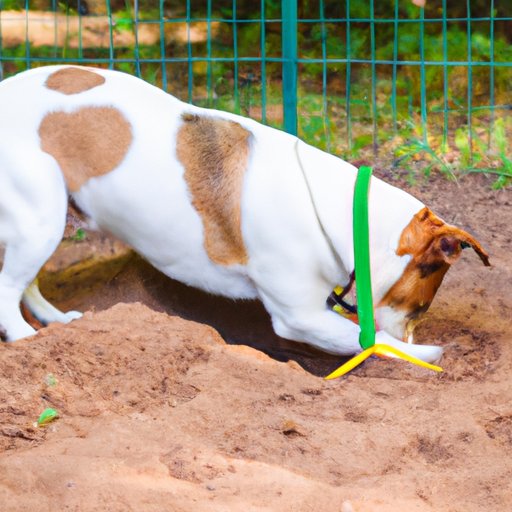I. Introduction
As a dog owner, you may have experienced the frustration of discovering your backyard dug up by your furry companion. Dog digging behavior can be challenging to deal with, but it’s important to understand the underlying reasons for the behavior and how to address it. This article aims to help dog owners understand and tackle dog digging behavior.

II. Understand the Root Cause of the Digging Behavior
Before you can address your dog’s digging behavior, it’s crucial to understand why dogs dig in the first place. Some dogs dig because it’s simply a fun and natural activity, while others dig for more specific reasons, such as boredom or anxiety. It’s also possible that the digging behavior is due to physical discomfort, like the need to cool down on a hot day.
Identifying the reason behind your dog’s digging behavior is crucial as it can guide you towards the most effective solution. Some ways you can identify the underlying cause of your dog’s digging behavior include observing their body language and behavior around the digging area or consulting with a professional dog trainer or veterinarian.
III. Increase Exercise And Mental Stimulation
Dogs that are not provided with enough exercise or mental stimulation can get bored and channel their energy into destructive behaviors like digging. You can help address digging behavior by making sure your dog has a routine for exercise and mental stimulation.
There are many ways to increase your dog’s exercise and mental stimulation ranging from a simple walk in the park to interactive puzzle toys. You can also switch up their exercise and stimulation routine to keep things interesting.
IV. Create A Designated Digging Area
One effective solution to dog digging behavior is to provide a designated area where your dog can dig and play, away from any areas you would not like them to dig. This allows your dog to dig in an area where digging is allowed without causing any damage or frustration. It can also help redirect your dog’s attention away from inappropriate areas.
There are different ways to create an appealing digging area, such as using a sandbox or even a specific area in your yard covered with sand or appropriate digging material. You can encourage your dog to dig in this designated area by using positive reinforcement techniques, such as treats and praise.
V. Create Barriers or Use Deterrents
If your dog is digging in areas that cannot be designated for digging, such as areas with sensitive plants or pool equipment, you may need to create barriers or use deterrents. These can include physical barriers like fencing or using different textures on the ground, like rocks or mulch, to discourage digging.
Deterrents are another way to discourage digging and can include citrus sprays, motion-activated sprinklers, or even burying chicken wire near the digging areas. Choosing the appropriate deterrence technique requires understanding the underlying cause of the digging behavior.
VI. Train Your Dog Using Positive Reinforcement Techniques
Positive reinforcement is a scientifically-proven training method that focuses on rewarding desirable behaviors and redirecting negative ones. Redirecting your dog’s attention away from digging and offering rewards for good behavior can be a powerful tool in addressing digging behavior.
You can use positive reinforcement techniques to train your dog to dig only in designated areas and to redirect their attention from inappropriate areas. Rewards can include treats and verbal praise to help motivate your dog to learn.
VII. When to Seek Professional Help
In some cases, digging behavior can be a symptom of underlying anxiety or behavioral issues. This is especially the case when the dog’s digging behavior is extreme or destructive. In these cases, it may be necessary to seek help from a professional dog trainer or veterinarian.
A professional trainer can help identify the root cause of the digging behavior and create a targeted training plan to address it. They can also provide guidance on appropriate exercise and mental stimulation routines and help with the use of positive reinforcement techniques.
VIII. Conclusion
Dog digging behavior can be a challenge for dog owners, but it’s important to address it with a clear understanding of why it occurs and how to best tackle it. The use of positive reinforcement techniques, creating barriers and designated digging areas, and increasing exercise and mental stimulation can all be effective ways to address the problem. Remember, if your dog’s digging behavior is extreme or destructive, it’s important to seek professional help.
